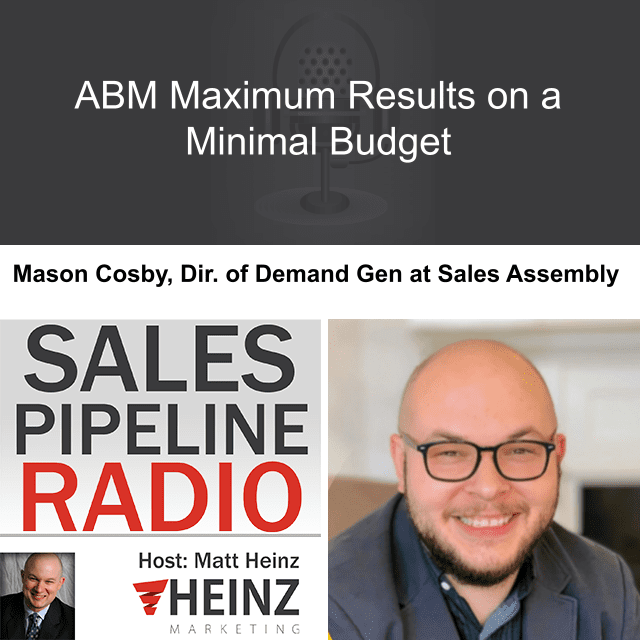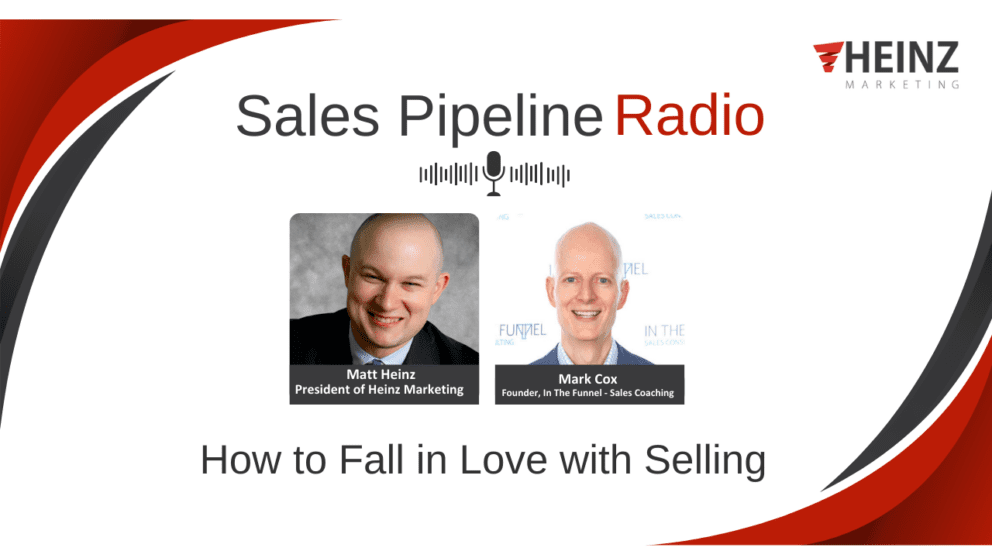Sales Pipeline Radio, Episode 335: Q & A with Mason Cosby

By Matt Heinz, President of Heinz Marketing
If you’re not already subscribed to Sales Pipeline Radio or listening live every Thursday at 11:30 a.m Pacific on LinkedIn (also on demand) you can find the transcription and recording here on the blog every Monday morning. The show is less than 30 minutes, fast-paced and full of actionable advice, best practices and more for B2B sales & marketing professionals.
We cover a wide range of topics, with a focus on sales development and inside sales priorities. You can subscribe right at Sales Pipeline Radio and/or listen to full recordings of past shows everywhere you listen to podcasts! Spotify, iTunes, Blubrry, Google Play, iHeartRADIO, Stitcher and now on Amazon music. You can even ask Siri, Alexa and Google or search on Audible!
This week’s show is entitled, “ABM Maximum Results on a Minimal Budget“ and my guest is Mason Cosby, Director of Demand Generation at Sales Assembly.
Tune in to hear more about:
- Marketing and sales role in serving the revenue team
- Common reasons why marketing and sales don’t operationally get along
- How companies can start aligning their marketing and sales teams
- Things to prioritize to drive short term impact and the building blocks for long term revenue impact
Watch the video, listen in below and/or read the transcript below.
Matt: All right, welcome everybody to another episode of Sales Pipeline Radio. I’m your host, Matt Heinz. Thank you so much for joining us in the middle of your work. If you’re joining us live today, not only are you joining us in the middle of your workday, but you are also drawing yourself away from March Madness Games, as we speak. I wanted to make it clear, I’m just keeping my eye on West Virginia and Maryland because it was one of my 8-9, Mason. Obviously for people watching this on demand, you’re like, I can’t believe that West Virginia made a run anyway. If you’re watching live, thank you for doing so. You can be part of the show today if you’ve got a question or comment on our topics for our guest, Mason Cosby. We would love to have you be part of the show. Make a question, make a comment, we’ll bring you in, we’ll ask your question, we’ll bring your comment up on screen and have some fun with it. If you’re watching and listening on demand, thank you very much for listening, downloading, and subscribing. Every episode of sales pipeline radio its always available past, present, and future on salespipelineradio.com. Today, Mason told me right before we started recording. Mason is phenomenal, he’s got a new job, he’s got a pending baby, he just got back from Scotland, he loves sales. Mason Cosby, everybody. Thanks for joining us, man.
Mason: I will always join anything you ask because you are a legend in and of yourself. So, I’m just excited to be here.
Matt: Legend in my own mind, I think is what you just said. So, yeah, that’s all good. Well, I’ve been following you for a long time as well. You continue to have great content, great insights. For the folks that don’t know you, give just a little bit about who you are, where you’re from and what you’re thinking about these days.
Mason: Yeah, if you actually look behind me on every call, I join in. My wife gave me these wonderful maps that actually tell a little bit of our life stories. So from Birmingham, met my wife and then in Jackson, Mississippi, is where I started my marketing career and within the past year and a half, moved up to Indianapolis and have been here working at an agency and recently transitioned over to an incredible company called Sales Assembly that is offering elevated learning and development for go-to-market teams. So essentially, we help train your sales and CS teams to make more money, which is why I heart sales.
Matt: You love sales. I think your past few roles and just the conversations we’ve had, you know, you are a marketer at heart, a marketer by experience. But you know, you realize and lean into the fact that you can’t be a successful marketer in B2B without also having a successful sales team. And you are now marketing at a company whose customer is sales. So, I know this is a new role to you, but talk to me about why that was a priority for you in terms of the next role in your career but also just in terms of leaning into that integrated role as a marketer?
Mason: Yeah. So, there’s two really big reasons. One, the previous company I worked for was actually acquired and I ended up stepping into a sales role for about six months, selling ABM programs to other marketers and selling today is just really difficult. As a marketer, you know, I get a relatively open calendar where I get to do deep and meaningful work and get to build really cool programs and have the time of my life. But when I stepped into a sales role, the work was meetings. I mean, the best salesperson is in back-to-back to back meetings. And I mean you got to always be on because if you’re not on, you’re not putting your best foot forward, you’re the representative of the company like that’s, that’s difficult. And the flip side is, I had one week that was super slammed, literally 70 hours of meetings, the next week was a desert and I mean, that just wears on you. So, I just have a deep empathy for sales, having recently been in the role. And honestly, throughout my career, kind of gone back and forth between marketing and sales. And as I looked at the next role that I wanted to step into, I genuinely love the revenue team. I love serving the B2B revenue teams and specifically in my own life, I mean, professional development has been the massive career accelerator. So, when I looked at what sales simply offered of learning and development for the go-to-market team, specifically focusing in on that sales team, it seemed like a perfect fit to go build a marketing program that actually helps salespeople elevate their career and actually drive greater impact in their organizations.
Matt: So, I want to ask a follow-up question on something you said that I wrote down about serving the revenue team. And I think I want to qualify a couple of ways and get your opinion on this because I think as a modern B2B marketer, you are part of the revenue team, right? I mean, today’s modern B2B marketing needs to be revenue responsible. And then sometimes I think some people here serving the revenue team and think that that means you are in a subservient role. So talk a little bit about what you mean by serving the revenue team as well as your perspective on marketing’s role on the revenue team.
Mason: So, I’ll give you two answers. One, when I was saying, serve the revenue team, I was looking at the next job, I wanted to be sure that I stuck in kind of this B2B audience that was focused on the revenue team. So, I had some other jobs that were looking at like the finance department and the HR side of things. So for me, I just love serving the revenue teams. And then as far as actually sitting in a marketing seat and talking through that concept of serving the revenue team, practically what has happened for years and years as marketing goes off and does their own thing and sales does their own thing. There’s this complete mismatch of who we’re actually pursuing and going after. If you were to ask marketing, who your ideal clients are, they have this kind of idealistic version. And when you go ask sales, they’re gonna tell you probably the easiest closes that they’ve experienced that may or may not actually be the best fit. So, I love sitting in a marketing role because I look at the revenue team as marketing, sales, and customer success. So, sitting in a marketing role, my job is to make sure that we’re targeting the right people, going after the right people, engaging the right people, from the start. It makes sales’ job easier actually in the close, but not just to get easy sales, but so that we can keep clients for years and years to come, making customer successes job also easier and better. Because I think everybody’s been in a support role at some point in dealing with unhappy clients that were sold, this vision and a promise that could never be delivered as always just incredibly frustrating and demoralizing. I want to make sure that clients and everyone in the revenue team are actually set up for success.
Matt: Talking today on Sales Pipeline Radio with Mason Cosby. He’s the new director of demand gen at Sales Assembly, also check out his podcast, The Marketing Ladder really appreciated just the content in this, in the guests you get there as well. There are some people that are nodding vociferously, as we talk about sort of a combined revenue team and revenue responsibility. But you and I both know, especially, you know, with your time at gravity and elsewhere like this isn’t always the reality, this isn’t always even like imminently possible. What are some of the common reasons you see why marketing and sales can’t operationally get along and what are some things that companies can start to do? Not just to improve the relationship, but really to improve the impact. It’s very much a one plus one equal seven kind of situation if you can do it right.
Mason: I mean, practically I’ve now worked within Sales Assembly for, I think today is day 18. I have seen to no fault of anybody, four different target account lists, that all had different criteria because essentially people go into ZoomInfo or an ample marketer or sales <inaudible 00:07:52> and they pull their own target account list. Based off of their own ideas of what are our best fit customers. So, sales has got one. I got a different one from rev ops. I got a different one from a new salesperson that’s bringing in kind of his network. And then I’m actually going through and essentially developing my own. So again, we’ve got all these different people that are building the target account list and again, they’re married to it. They love this because this is their list. When in reality, there needs to be an objective view of who are the best fit customers. So, I talked about this recently on LinkedIn, I think that everybody, you know what used to be the target account list. I think another way to frame and I love saying is new um turn around this from move is the total relevant market. So, identifying who is the best market for us to pursue because especially sales assembly serves B2B tech, there’s like 100,000 B2B tech companies. We’ve got two marketers and we’ve got two sales people – we got four people. So, if we all tried to go after 100,000 accounts, it wouldn’t be very effective. But what we’ve done is create a total relevant market, about 2500 accounts. This is our pool to build out these segmented lists from for the next two or three years. And we’re going to make sure that we are doing some kind of always-on demand type programs that are making people aware. But then when we see specific surges and intent, when we see we’ve got some road shows and we can pull in specific contacts that are at these accounts, were being sure that all of our marketing and sales programming is focused and targeted towards an actual relevant market. And what that has done is brought alignment because it’s large enough that everybody can kind of get around it and say this makes sense, but it’s also focused enough that you can actually get everybody rowing in the same direction. So, I think that there has to be a definition at the top, of what is our total relevant market, how we’re going to identify it and then how does marketing, and sales actually partner to build out segmented list and specific campaigns.
Matt: So smart and you’re making me realize that sales and marketing have a “more” problem, right? Like I’ve always kind of complained about the marketing of more. That many companies are like we want more leads, we want more clicks, more likes, we want these up into the right charts. More is sometimes more counterproductive in B2B alone, let alone complex sales situations. But you’re absolutely right, that sales sometimes has the same “more” problem. We want to target bigger markets because it gives us more at bats. We want more leads even if just give our sales team a chance to sell. Whereas you’re right, you go from total addressable market to if you’re watching, like my hands are getting closer, like from a total addressable market to serviceable obtainable market, which is a subset of the subset of what most companies think of as their target market. But that’s a scary thing, Mason because now I’m saying I have fewer bats. I’m saying I’m going after a smaller market and I get nervous that if I can’t convert enough, I’m not going to hit my number. Should I be talking to more people because then I can have more, better chances of hitting my number. It’s counterintuitive, but that’s actually not true.
Mason: Yeah, if I may just add on that point, I was talking with our salesperson about this concept just yesterday. And the first thing he said is honestly what keeps me up at night as a salesperson is not who we’re going after, but who I missed. So again, when you think about this idea that we’re going to intentionally focus and limit it is somewhat intimidating. But what I also want to recognize is for a lot of B2B companies right now, they are still building in public. So they are creating organic content that reaches whoever the algorithms lets it reach, they’ve got their own database. What I’m just saying is yes, still do those things that have a wider net. But as far as okay, I want to send my salesperson to do direct outbound. How do we pull that list? I want to run an ad program on LinkedIn or on Facebook, sorry Meta or on, Google. How do we focus that? So we’re not spending to reach 100,000 B2B accounts. But we’re saying we want some brand awareness type ads, let’s focus on our relevant market. So again, I couldn’t agree more because again, to your point, when we focus, it feels like we’re limiting the opportunities when in reality nobody’s hopping on the call unless they feel like it’s actually going to resonate. So, when you focus, it resonates more, and people actually hop on the call.
Matt: So, I’ve seen some companies and we have a, we do a version of this internally where we have a very distinct target account criteria. We’ve got our tight list and it’s not just a set of criteria if you do this, right. It’s not just filters, it’s a real account list. So, you should know exactly what companies you believe fit in that criteria and that’s dynamic. Some people leave it, some people join it. I’ve seen companies and we do this a little ourselves, have sort of three categories. We got proactive, reactive and no fly zone. Proactive means, here’s the companies and our service obtainable market that we’re going after right now that we think we have a, we have a great product for. There’s reactive, meaning there’s companies that I don’t know if they’re qualified or I don’t see that they’re qualified, but if they come to us and exhibit qualification traits, like obviously I will service them, I will sell to them, but I don’t want our team to probably go after them. And then there’s the companies that we have no business doing business with. And then the definition of those is different for different people. But I think to recognize what it takes to be in each of those areas and sticking with those definitions until you make adjustments intentionally to change the, where the lines are. But what do you think about the concept of saying okay, like we have our service will obtainable market, but we’re willing to sell to other people as long as they meet some of those criteria?
Mason: I think practically we are 100% aligned because when we are creating this organic content and when you really start to create great content, even if it’s targeted and it’s personalized, there is still dark social, there is still a ton of communities where people will start to talk. So again, I think of this addressable serviceable market as the absolute best fit potential customers. But then these other, people that may come inbound, they’re good fits, not the best fits, but they make for good clients will be able to help them. So again, I’m on the same page on that front. I just think from an intentional targeting, where are we going to put our ad dollars, where are we going to do direct outbound and sequencing and who are we going to cater our content creation for? I think it’s for the addressable serviceable market. But also knowing that by the nature that we’re doing good marketing, other people will inevitably come in and we need to have clear criteria around who is a yes and who is an immediate disqualification.
Matt: We just got a few more minutes here on this episode of Sales Pipeline Radio with our guest Mason Cosby. He’s less than two months into a new role, also a pending father. So, congrats, announced that last month, which is amazing. But in a new role and sort of owning the full demand gen function without giving away your whole playbook. What are the things that you start to prioritize as you look at what can drive maybe short term impact? What are the things that are building blocks for long term, having more predictable outcomes from the work that you’re doing? What are some of the strategies you’re using to build your go to market plan now?
Mason: Yeah. So, if you want my full playbook, I’m actually very publicly documenting every single thing that I’m doing through TikTok, that has been reposted to LinkedIn and I’ve actually shared on LinkedIn the 30-60-90 with tactical execution that I built for my interview process. So again, I’m actually happy to give all of that away if anybody wants to message me on LinkedIn because you know, everybody talks about their secret sauce. But I had a previous boss say that everybody’s secret sauce is really just 1000 island dressing. So again, it’s the same strategy, it’s the same playbooks. But how do you execute that for your business is the real clear differentiator. So, with that, the immediate thing we need to build is a content engine that is publicly accessible. Sales Assembly has provided, you know, for the past few years, upwards of 10 weekly trainings for 200 B2B tech clients. None of it has been publicly accessible. The amount of content that this company produces is absurd. So, how do we pull some of it out to then show the market the value that they could get if they were to buy an all-inclusive membership. Its first building the initial content engine that is around from my perspective, these live type events. The second thing is then how do we create a repurposing engine? You know, we’ve got an incredible team over here. I mean, the former VP of Rev Ops at G2, we’ve got numerous like serial entrepreneurs, investors and portfolio advisors. We’ve got the best people in enablement that I’ve ever seen. This team it’s 15 people strong, but it’s just some of the heaviest hitters I’ve literally ever seen in one space and they’re so busy building that they don’t have the time to actually share their incredible thoughts. So, how do we then create pillars in which they can do that, takes an hour or two a month from them, but then we repurpose that and actually turn them into thought leaders that are getting invited to speak. Because again, we’re also an education company. We do learning and development. The best thing that we can do is start to educate the market on how they should be thinking about sales enablement, how they should be thinking about revenue learning and development. And actually, starting to give them a taste of what our product looks like so that they actually buy that membership. So that’s the crux. That’s the basis. There’s a lot more in that. Like tactically, we’re implementing user gems because we have such good member carry over. So that when somebody changes their job, because the average CROs changes jobs every 18 to 24 months. If they view just for two years and move to a new company, we can maintain that previous relationship and go with them where they go. So again, thinking some of those practical tactical things, but really just comes down to great content, incredible thought leadership and an intentional connection strategy on LinkedIn to continue to further grow our network so that we’re starting to connect and become friends with our ideal customers and our target accounts.
Matt: We try to keep these less than 20 minutes, Mason. I figure, you know, if I can get a podcast where if you cut, if you carve out half an hour to listen or watch, you get your content, you can go to the bathroom, you can get a drink, get back to work or you listen the whole thing on the way to the market and back and you’re done. I like our engagement there. I’m also very disappointed that West Virginia lost while we were recording this, West Virginia lost by two points. They weren’t like a big underdog, there was a nine against an eight, but my brackets is already messed up. So, the struggle is real.
Mason: So sorry, Matt.
Matt: Yeah, it’s okay. Well, listen, Mason, thank you for joining us today. If people want to learn more about you, I think you mentioned that your go-to-market plans are very public. You’ve got your podcast, TikTok. What are some places people can go to check your stuff out?
Mason: I mean, the main one is LinkedIn. I don’t have a newsletter like LinkedIn, my LinkedIn feed is essentially just a constant stream of my thoughts, anything going on. So, if you want to keep up to date on everything, go to LinkedIn, you can also find me on TikTok at @MarketingMason. You can find my podcast Marketing Ladder. But really my main one is LinkedIn. So, if you want to connect with me, talk with me anywhere, find me.
Matt: That’s awesome Mason. Thank you so much for your time today. Thanks everyone for listening and watching. We’ll be back next week for another episode of Sales Pipeline Radio. Until then, my name is Matt Heinz. We’ll see you next week. Take care.
Listen to the Latest Episodes:





